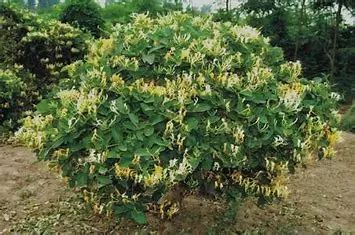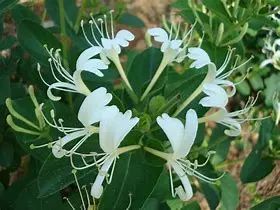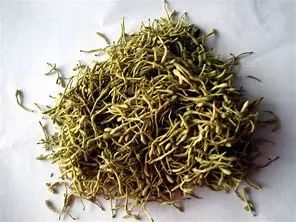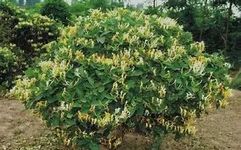



《中药大辞典》:金银花
拼音 Jīn Yín Huā
别名 忍冬花 (Rén Dōng Huā), 银花 (Yín Huā), 鹭鸶花 (Lù Cè Huā), 苏花 (Sū Huā), 金花 (Jīn Huā), 金藤花 (Jīn Téng Huā), 双花 (Shuāng Huā), 双苞花 (Shuāng Bāo Huā), 二花 (Èr Huā), 二宝花 (Èr Bǎo Huā).
出处 《履巉岩本草》
来源 The flower buds of the plant 忍冬 (Lonicera japonica) from the Caprifoliaceae family. Collected in May to June during sunny mornings after dew has dried, the flower buds are spread out to dry in the shade, ensuring to turn them regularly to prevent blackening. Avoid direct sunlight exposure. Store in a dry, ventilated place to prevent insect infestation and discoloration.
生境分部 Found in most regions of China, with the highest yield in Shandong and better quality in Henan.
性状 The dried flower buds are long and rod-shaped, slightly curved, measuring about 2-3 cm in length, with a thicker upper part, diameter approximately 1.5-3 mm. The exterior is yellow or yellow-brown, covered with short soft hairs and glandular hairs. The base has small green sepals, 5-lobed, with triangular lobes that are hairless. When split open, 5 stamens and 1 pistil can be seen. The corolla is lip-shaped, with the stamens and pistil protruding. It has a fragrant aroma and a slightly bitter taste. The best quality is characterized by unopened flowers that are yellow-white and plump.
化学成分 The flowers contain about 1% luteolin, inositol, saponins, and tannins.
药理作用 ① Antibacterial effects
In vitro, it inhibits various bacteria (Salmonella typhi, Salmonella paratyphi, Escherichia coli, Proteus, Pseudomonas aeruginosa, Bordetella pertussis, Vibrio cholerae, Staphylococcus, Streptococcus, Streptococcus pneumoniae, Neisseria meningitidis, etc.). Sensitivity reports vary, but generally, it shows strong activity against Salmonella, especially against typhoid and paratyphoid bacteria. At high concentrations, it can inhibit Shigella, while at lower concentrations, it is more effective against Shigella dysenteriae than Shigella flexneri. It is also reported that honeysuckle extract is effective against Staphylococcus aureus but not against E. coli. It has antibacterial effects against common bacteria in chronic bronchitis (Streptococcus pneumoniae, Streptococcus pyogenes, and Haemophilus influenzae) (plate method). Additionally, it can induce morphological changes in sensitive bacteria without affecting Gram staining properties. High-pressure sterilization significantly affects its antibacterial efficacy. The efficacy decreases after decoction. The exact active components remain unidentified, but early reports suggested a non-volatile oily substance with high water solubility and stability, maintaining antibacterial activity for 3-4 weeks when refrigerated. It is said that the leaves have stronger antibacterial effects than the flowers, which requires further study.
Honeysuckle shows some inhibitory effects on human-type Mycobacterium tuberculosis in vitro. In experimental treatments on mice inoculated with human-type Mycobacterium tuberculosis, honeysuckle significantly alleviated pulmonary lesions, although the bacteria could still be detected in direct smears and cultures. Its water extract (1:4) shows mild inhibitory effects on certain skin fungi in vitro. The decoction has minimal effects on skin fungi, but on media containing 30% honeysuckle, some fungi exhibit varying degrees of green halo phenomena, the significance of which remains to be elucidated. The water decoction shows stronger antibacterial effects against Leptospira than alcohol extracts, but weaker than Coptis chinensis or Lychee grass. It can also delay the pathogenic effects of respiratory viruses on cells. The Yin Qiao San (Syrup) has inactivating effects on the PR strain of influenza virus in vitro; however, it has no effect on viral replication in chicken embryos.
② Other effects
In fasting rats given large amounts of cholesterol, co-administration of honeysuckle (2.5 g/kg) resulted in lower blood cholesterol levels compared to the control group, suggesting that honeysuckle may reduce intestinal absorption of cholesterol. The flow infusion of honeysuckle showed no significant effects on respiration, blood pressure, or urine volume in rabbits and dogs, with a slight increase in respiratory amplitude and minor inconsistent changes in blood pressure; absorption was incomplete whether taken orally or injected; it has local irritant effects. Its toxicity is low, with the LD50 for subcutaneous injection in mice being 53 g/kg. Additionally, it has been reported that honeysuckle hot water infusion has mild preventive effects on gastric ulcers in rats with pyloric ligation; when combined with pig kidney, Poria, ginseng, Euryale, and pearl, the preventive effects are stronger; the extract of the above combination has no direct effect on cancer cells but can alleviate the decrease in peroxidase and cholinesterase activity in the liver of cancer-affected animals.
炮制 Honeysuckle: Remove sand and impurities. Honeysuckle charcoal: Take cleaned honeysuckle, place it in a pot, and stir-fry over high heat until it turns dark brown, then spray with clean water, remove, and dry.
性味 Sweet, cold.
① 《滇南本草》: “Cold in nature, bitter in taste.”
② 《本草正》: “Sweet in taste, neutral in nature, slightly cold.”
归经 Enters the Lung and Stomach meridians.
功能主治 Clears heat and detoxifies. Treats febrile diseases, heat toxin blood dysentery, abscesses, swellings, scrofula, and hemorrhoids.
① 《滇南本草》: “Clears heat, detoxifies various sores, abscesses, and scrofula.”
② 《生草药性备要》: “Can dissipate abscesses and toxins, stop dysentery, wash sores, and eliminate blood heat from the skin.”
③ 《本草备要》: “Nourishes blood and quenches thirst. Treats scabies and eczema.”
④ 《重庆堂随笔》: “Clears wind-heat and damp-heat, detoxifies epidemic filth and evil turbid pathogens, calms the liver and gallbladder, and treats convulsions and epilepsy.”
⑤ Guangzhou Military Region’s “Commonly Used Chinese Herbal Medicine Manual”: “Clears heat and detoxifies. Treats external febrile cough, enteritis, bacterial dysentery, measles, mumps, septicemia, abscesses, appendicitis, external infections, and infant prickly heat. Made into a cooling tea, it can prevent heatstroke, colds, and intestinal infectious diseases.”
用法用量 Internal use: decoction, 10-20 g; or in pills or powders. External use: appropriate amount, ground into powder for application.
注意 Contraindicated in cases of spleen and stomach deficiency-cold and qi-deficient sores with clear pus.
复方 ① To prevent Japanese encephalitis and epidemic cerebrospinal meningitis: honeysuckle, forsythia, daqinggen, reed root, and licorice, each 3 qian. Decoction for tea, one dose daily for three to five days. (《江西草药》) ② For Taiyin wind warmth, warm heat, and initial winter warmth, but with heat not intolerant to cold and thirst: forsythia 1 liang, honeysuckle 1 liang, bitter apricot kernel 6 qian, mint 6 qian, bamboo leaves 4 qian, raw licorice 5 qian, schizonepeta 4 qian, light fermented soybeans 5 qian, burdock seeds 6 qian. Grind into powder, take 6 qian, decoct with fresh reed root. (《温病条辨》 Yin Qiao San) ③ For dysentery: honeysuckle (roasted in a copper pot until dry) 5 qian. For red dysentery, take with white honey water; for white dysentery, take with sand sugar water. (《惠直堂经验方》 Rén Dōng San) ④ For heat stranguria: honeysuckle, sea jinxian vine, coriander, golden thread root, and white grass root, each 1 liang. Decoction for daily use, five to seven days for a course of treatment. (《江西草药》) ⑤ For biliary tract infections and wound infections: honeysuckle 1 liang, forsythia, daqinggen, huangqin, and wild chrysanthemum, each 5 qian. Decoction for daily use. (《江西草药》) ⑥ For severe abscesses with purple-black discoloration: honeysuckle with branches and leaves (chopped) 2 liang, astragalus 4 liang, licorice 1 liang. Finely chop, add 1 liter of wine, seal in a jar, and boil in water for 3-2 hours, then take out, strain, and take all at once. (《活法机要》 Huichuang Jin Yin Hua San) ⑦ For all swellings and toxins, regardless of whether they have ruptured or are newly formed with fever, and for abscesses and throat phlegm: honeysuckle (with stems and leaves) half a bowl of natural juice, decoct to 80% and take, using the residue for application, dispelling toxins and harmonizing blood, with unique efficacy. (《积善堂经验方》) ⑧ For initial onset of abscesses: honeysuckle half a jin, boil in ten bowls of water until reduced to two bowls, add 2 liang of angelica, and boil until reduced to one bowl, take all at once. (《洞天奥旨》 Guī Huā Táng) ⑨ For all internal and external abscesses: honeysuckle 4 liang, licorice 3 liang. Decoction for immediate consumption, those who can drink should take it with wine. (《医学心悟》 Rén Dōng Táng) ⑩ For intestinal abscesses, where pressure cannot be applied, and the right foot is flexed and cannot be extended: honeysuckle 3 liang, angelica 2 liang, earthworm 1 liang, ophiopogon 1 liang, black shen 1 liang, raw licorice 3 qian, coix seeds 5 qian, and huangqin 2 qian. Decoction for consumption. (《洞天奥旨》 Qing Chang Yin) ⑾ For deep abscesses: honeysuckle, wild chrysanthemum, sea jinxian, malan, and licorice, each 3 qian, daqing leaves 1 liang. Decoction for consumption. It can also treat abscesses and sores. (《江西草药》) ⑿ For gas gangrene and osteomyelitis: honeysuckle 1 liang, centella 2 liang, a little red 1 liang, wild chrysanthemum 1 liang, white grass root 1 liang, white flower snake tongue grass 2 liang, and earth gall grass 1 liang. Decoction for consumption. Additionally, use fresh privet fruit and Hedyotis as appropriate for external application. (《江西草药》) ⒀ For early acute mastitis: honeysuckle 8 qian, dandelion 5 qian, forsythia and dried tangerine peel each 3 qian, green peel and raw licorice each 2 qian. This is one dose, decoct twice, and take in two doses, one dose daily; in severe cases, two doses can be taken in one day. (《中级医刊》(3):167,1964) ⒁ For long-standing breast lumps that gradually enlarge, with red discharge and deep ulcers: honeysuckle and astragalus (raw) each 5 qian, angelica 8 qian, licorice 1 qian 8 fen, and 50 pieces of bitter orange leaves. Decoction with equal parts of water and wine. (《竹林女科》 Rén Huā Táng) ⒂ For Yangmei toxin: honeysuckle 1 liang, licorice 2 qian, black soybeans 2 liang, and earth poria 4 liang. Decoction, one dose daily, must be fully consumed. (《外科十法》 Rén Dōng Táng) ⒃ For pesticide (organic phosphorus agents such as 1059, 1605, 4049) poisoning: honeysuckle 2-3 liang, alum 2 qian, rhubarb 5 qian, and licorice 2-3 liang. Decoction and take cold, one dose at a time, two doses a day. (Xuzhou “Single Prescription Experience Method Compilation”)
各家论述 ① 《本草通玄》: “Honeysuckle is used for abdominal distension and diarrhea, dissipating abscesses and toxins, replenishing deficiency and treating wind. People only know its detoxifying effects, but are unaware of its benefits for abdominal distension and wind deficiency. I have used it for various conditions and have repeatedly seen effective results.”
② 《本草正》: “Honeysuckle is good at transforming toxins, thus treating abscesses, swellings, sores, eczema, Yangmei, and rheumatic toxins, making it an essential medicine. It can disperse undeveloped toxins and promote the rupture of developed toxins, but its nature is mild, so it should be used in larger quantities, either boiled with wine, or juiced and mixed with wine for immediate consumption, or ground and mixed with wine for thick application. For treating scrofula and upper qi toxins, using about 1 liang regularly boiled is extremely effective.”
③ 《本经逢原》: “Honeysuckle detoxifies and removes pus, with a balance of purging and tonifying effects, making it a holy medicine for post-abscess rupture. However, it should not be used in cases of qi deficiency with clear pus, poor appetite, and diarrhea. For pockmarks that are sunken and not raised, using this root in long flowing water for bathing is effective, which is a modified method of the water willow decoction.”
④ 《滇南本草》: “Clears heat, detoxifies various sores, abscesses, and scrofula.”
⑤ 《生草药性备要》: “Can dissipate abscesses and toxins, stop dysentery, wash sores, and eliminate blood heat from the skin.”
⑥ 《本草备要》: “Nourishes blood and quenches thirst. Treats scabies and eczema.”
⑦ 《重庆堂随笔》: “Clears wind-heat and damp-heat, detoxifies epidemic filth and evil turbid pathogens, calms the liver and gallbladder, and treats convulsions and epilepsy.”
⑧ Guangzhou Military Region’s “Commonly Used Chinese Herbal Medicine Manual”: “Clears heat and detoxifies. Treats external febrile cough, enteritis, bacterial dysentery, measles, mumps, septicemia, abscesses, appendicitis, external infections, and infant prickly heat. Made into a cooling tea, it can prevent heatstroke, colds, and intestinal infectious diseases.”
摘录 《中华本草》

